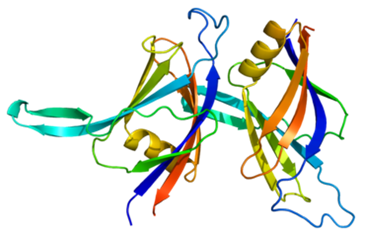Delta subfamliy
Protein kinase C delta type (or PKC-δ) is an enzyme that in humans is encoded by the PRKCD gene. PKC-δ is one of the important members of the PKC family. Under physiological conditions, the expressed PKC-δ mainly exists in the cytoplasm in an inactive form, but after being activated, PKC-δ can migrate to the plasma membrane and start the downstream signal pathway system, participating in the cell proliferation, differentiation and apoptosis processes. At present, it is believed that PKC-δ has dual effects on the regulation of apoptosis, which is shown by pro-apoptotic and anti-apoptotic effects. Therefore, the abnormal expression and activation of PKC-δ is closely related to the occurrence of various diseases, especially the abnormal apoptosis of tumor cells Plays an important role.
 Figure 1. Protein structure of PRKCD gene.
Figure 1. Protein structure of PRKCD gene.
Functions
Protein kinase C is a cytoplasmic enzyme. In unstimulated cells, PKC is mainly distributed in the cytoplasm in an inactive conformation. Once a second messenger is available, PKC will become a membrane-bound enzyme. It can activate enzymes in the cytoplasm and participate in the regulation of biochemical reactions. It can also act on transcription factors in the nucleus and participate in the regulation of gene expression.
PKC-δ activation
PKC-δ activation is an early event of apoptosis and occurs before morphological changes in cells. However, under physiological conditions, PKC-δ is usually mainly present in the cytoplasm in an inactive and redundant form. Under the influence of apoptosis-inducing factors, PKC is activated through a multi-step process such as allosteric effect, Phosphorylation of PKC-δ: The activation of PKC requires phosphorylation of the active ring. For example, phosphorylation of the activation ring Thr 505 is necessary for cPKC / aPKC to produce a catalytically active form. Thr505 phosphorylation of PKC-δ can increase allosteric effect and activate its catalytic activity. Unlike other members of the PKC family, even though Thr505/Ser662 is not phosphorylated, PKC-δ may still be a functional kinase, but Thr505/Ser662 unphosphorylation can reduce the catalytic activity of PKC-δ by 90%.
PKC-δ shift
PKC-δ is a translocatable enzyme, especially activated PKC-δ can selectively bind to its specific substrate through migration. PKC-δ is translocated to a specific subcellular unit and phosphorylates its specific substrate, and interacts with different signaling proteins to exert different cellular effects. Different apoptosis-inducing agents can induce different translocations of PKC-δ, such as cytarabine-treated HL-60 cells and ionizing radiation MCF7 cells PKC-δ shifted into the nucleus; UV-irradiated rat JB6 epidermal cells showed that activated PKC-δ was translocated from the cytoplasm to the cell membrane, and then JB6 cells were induced to induce apoptosis by activating Erks and JNKs; When keratinocytes, activated PKC-δ shifts to mitochondria, which then induces the release of cytochrome C and apoptosis, and unactivated PKC-δ shifts to the cell membrane; ceramide and I FN-7 can induce PKC-δ to the Golgi apparatus. Shift. Glioma cells transfected with Sindbis virus (SV), PKC-δ translocates to the endoplasmic reticulum, and tyrosine phosphorylation occurs; activated PKC-δ can inhibit SV-induced apoptosis, and specific sites of PKC-δ Phosphorylation of tyrosine is essential for its anti-apoptotic effect.
PKC-δ promotes decay
Activation of PKC-δ or PKC-δCF in the process of initiating the downstream signaling pathway system requires interaction with other cellular signaling pathway systems to complete cell apoptosis.
References
- Micol V; et al. Correlation between protein kinase C alpha activity and membrane phase behavior. Biophysical Journal. 1999, 76 (2): 916-27.
- Steinberg SF; et al. Distinctive activation mechanisms and functions for protein kinase Cdeha. Bioehem J, 2004, 384 (Pt 3): 449-459